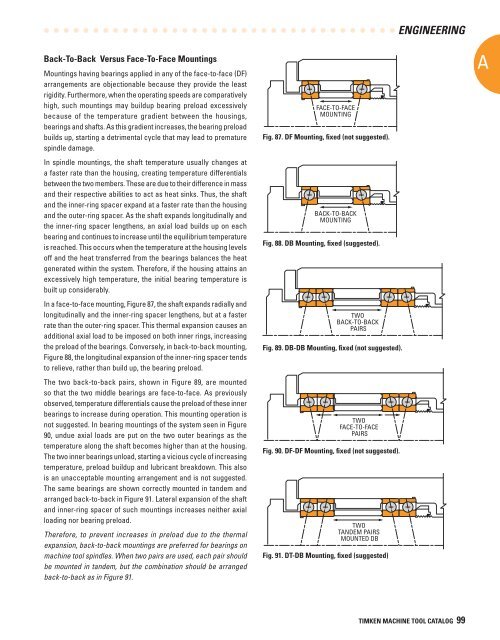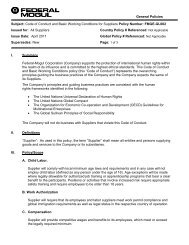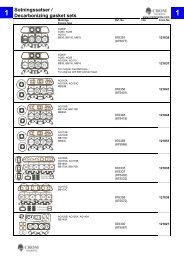You also want an ePaper? Increase the reach of your titles
YUMPU automatically turns print PDFs into web optimized ePapers that Google loves.
Back-To-Back Versus Face-To-Face Mountings<br />
Mountings having bearings applied in any of the face-to-face (DF)<br />
arrangements are objectionable because they provide the least<br />
rigidity. Furthermore, when the operating speeds are comparatively<br />
high, such mountings may buildup bearing preload excessively<br />
because of the temperature gradient between the housings,<br />
bearings and shafts. As this gradient increases, the bearing preload<br />
builds up, starting a detrimental cycle that may lead to premature<br />
spindle damage.<br />
In spindle mountings, the shaft temperature usually changes at<br />
a faster rate than the housing, creating temperature differentials<br />
between the two members. These are due to their difference in mass<br />
and their respective abilities to act as heat sinks. Thus, the shaft<br />
and the inner-ring spacer expand at a faster rate than the housing<br />
and the outer-ring spacer. As the shaft expands longitudinally and<br />
the inner-ring spacer lengthens, an axial load builds up on each<br />
bearing and continues to increase until the equilibrium temperature<br />
is reached. This occurs when the temperature at the housing levels<br />
off and the heat transferred from the bearings balances the heat<br />
generated within the system. There<strong>for</strong>e, if the housing attains an<br />
excessively high temperature, the initial bearing temperature is<br />
built up considerably.<br />
In a face-to-face mounting, Figure 87, the shaft expands radially and<br />
longitudinally and the inner-ring spacer lengthens, but at a faster<br />
rate than the outer-ring spacer. This thermal expansion causes an<br />
additional axial load to be imposed on both inner rings, increasing<br />
the preload of the bearings. Conversely, in back-to-back mounting,<br />
Figure 88, the longitudinal expansion of the inner-ring spacer tends<br />
to relieve, rather than build up, the bearing preload.<br />
The two back-to-back pairs, shown in Figure 89, are mounted<br />
so that the two middle bearings are face-to-face. As previously<br />
observed, temperature differentials cause the preload of these inner<br />
bearings to increase during operation. This mounting operation is<br />
not suggested. In bearing mountings of the system seen in Figure<br />
90, undue axial loads are put on the two outer bearings as the<br />
temperature along the shaft becomes higher than at the housing.<br />
The two inner bearings unload, starting a vicious cycle of increasing<br />
temperature, preload buildup and lubricant breakdown. This also<br />
is an unacceptable mounting arrangement and is not suggested.<br />
The same bearings are shown correctly mounted in tandem and<br />
arranged back-to-back in Figure 91. Lateral expansion of the shaft<br />
and inner-ring spacer of such mountings increases neither axial<br />
loading nor bearing preload.<br />
There<strong>for</strong>e, to prevent increases in preload due to the thermal<br />
expansion, back-to-back mountings are preferred <strong>for</strong> bearings on<br />
machine tool spindles. When two pairs are used, each pair should<br />
be mounted in tandem, but the combination should be arranged<br />
back-to-back as in Figure 91.<br />
FACE-TO-FACE<br />
MOUNTING<br />
Fig. 87. DF Mounting, fixed (not suggested).<br />
BACK-TO-BACK<br />
MOUNTING<br />
Fig. 88. DB Mounting, fixed (suggested).<br />
TWO<br />
BACK-TO-BACK<br />
PAIRS<br />
Fig. 89. DB-DB Mounting, fixed (not suggested).<br />
TWO<br />
FACE-TO-FACE<br />
PAIRS<br />
Fig. 90. DF-DF Mounting, fixed (not suggested).<br />
TWO<br />
TANDEM PAIRS<br />
MOUNTED DB<br />
Fig. 91. DT-DB Mounting, fixed (suggested)<br />
ENGINEERING<br />
A<br />
TIMKEN MACHINE TOOL CATALOG 99







